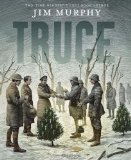
 Truce
TruceReview posted March 17, 2011.
Scholastic Press, New York, 2009. 116 pages.
Starred Review
Jim Murphy's book is an excellent introduction to World War I. With photographs and maps, and quotations from firsthand sources he explains the basics of why the war began and all the countries involved. Then he talks about the trenches:
In the autumn days ahead, there would be more charges and countercharges. Heightening the misery was a series of torrential rainstorms, some lasting several days. By October, the armies had come to a grinding halt on every front. "The energies of [all warring] armies flagged," wrote historian John W. Wheeler-Bennett, "worn out by defeats, fighting, and the vileness of the [now] swampy country."
Fierce fighting continued, but no army seemed capable of driving back the enemy. Instead, soldiers struggled from village to village, then farm to farm, until the lines of battle seemed to hardly move at all. The closeness of the enemy and rising casualty rates forced the commanders of both sides to make a momentous decision. Soldiers would begin digging trenches to hide from the killing fire.
Jim Murphy describes trench warfare and the awful conditions. Then he turns his attention to an aspect of World War One that I knew nothing about: when the soldiers in the trenches, on both sides, refused to fight for Christmas.
He quotes from people who were there, such as British soldier Graham Williams:
Williams and the men in his company watched as more trees appeared along the enemy's battle line. Then, suddenly, "our opponents began to sing 'Stille Nacht, Heilige Nacht.'... They finished their carol and we thought that we ought to retaliate in the same way, so we sang 'The First Nowell,' and when we finished that they all began clapping. And so it went on. First the Germans would sing one of their carols and then we would sing one of ours, until when we started up 'O Come All Ye Faithful' the Germans immediately joined in singing the same hymn to the Latin words 'Adeste Fideles.' And I thought, well, this was really a most extraordinary thing -- two nations both singing the same carol in the middle of a war."
The story that emerges is actually an inspiring one, even though it's coming out of war. And the story is true, as you can tell by Jim Murphy's meticulous research. Unfortunately, the commanders and others in charge of the war were not at all happy about the Christmas truce. But the story does make you think.
I like the reflections of Major Murdoch McKenzie Wood on the last page of this story:
Wood was in the trenches in 1914 and participated in a truce that lasted over two weeks. "I . . . came to the conclusion that I have held firmly ever since, that if we had been left to ourselves there would have never been another shot fired. For a fortnight that truce went on. We were on the most friendly terms, and it was only the fact that we were being controlled by others that made it necessary for us to start trying to shoot one another again."
This focus on the Christmas Truce shines a fascinating light on this well-documented history of World War I for upper elementary and middle school kids. What a great context for examining the reasons wars are fought.
